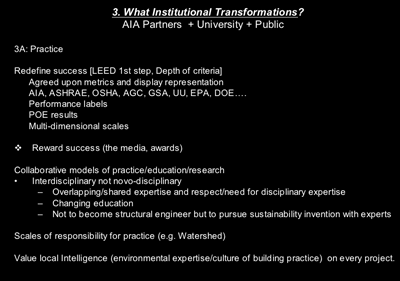|
|
So what institutional transformations are needed? We dealt with the AIA, and its partners, universities and the public. We thought the one thing that was really important is to redefine success. LEED is really only the first step. Yes, it's simplistic but it's also really easy to understand. The public realizes what gold or silver is and this is the beginning of what could be a much deeper set of criteria. These deeper criteria could involve the efficiency of the building, the simple tonnage of steel used, or the embodied energy or all of these kinds of things that could be measured and potentially rated, or somehow holistically looked at so you could say a building performs well or just maybe thermally it does really well.
LEED doesn't do very well in terms of efficiency or the structure or any of these other deeper aspects mentioned. We need something that would be far deeper and more holistic. It would be something that we thought was not only the evaluation but the display of it. The analysis of it could somehow be self-explanatory or that we had some resource implications for.
If that was really going to happen, we would actually have to have agreed-upon metrics that would come from the AIA, ASHA, OSHA, AGC, GSA, EPA, DOE. We would need all of those acronyms names speaking but we stopped listening at a certain point. We also thought it was important, while you're redefining success by these deeper metrics, that you reward success. Merit awards would not just be for buildings that looked great but would really start to begin to reward and put emphasis on buildings that had this much deeper criteria. That would potentially influence the media and start to get more public awareness of the larger goals of the architecture beyond just what it looked like.
|
|

 |
Also addressed were collaborative models of practice, education, and research. Education was a major topic. In the education part, we thought the early design years were the most critical time where you could make students aware of the new criteria for success and that a lot of it involved building technology. There were a lot of different models that we threw out on the table. Things like studios would have to be partnering with practitioners and officers. There was a model in which, when working with an office, you actually received a billable number. So when people teach, they get a certain number of hours they can distribute. They can use it themselves or they can get their colleagues engaged with you and all of that firm’s staff. That is going to take extra time on the part of the people working who were actually built into the commitment on the part of the office to support the schools.
|
>
01 02 03 04 05 06 07 |
